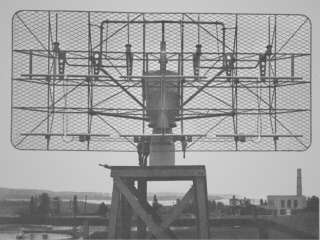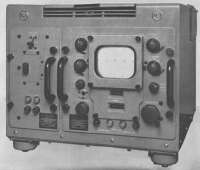SR
Description of the radar set, tactical-technical characteristics

Figure 1: SR antenna, the top row with the vertical dipoles is intended for the IFF.

| Specifications | |
|---|---|
| frequency: | 175 … 225 MHz
(VHF-Band) |
| pulse repetition time (PRT): | |
| pulse repetition frequency (PRF): | 60 or 200 Hz |
| pulsewidth (τ): | 1; 4 or 20 µs |
| receive time: | |
| dead time: | |
| peak power: | 300 kW |
| average power: | |
| instrumented range: | 200 mi (≙ 320 km) |
| range resolution: | 150 m |
| accuracy: | ±90 m; ±2° |
| beamwidth: | 20° |
| hits per scan: | |
| antenna rotation: | 1¼ or 7 min-1 |
| MTBCF: | |
| MTTR: | |
SR
The SR (Search Radar) was an operating in VHF-Band long-range search radar, primarily designed for aircraft detection, for installation on destroyers and larger vessels. The mission focused on the Pacific theater of war.
The antenna was a so-called “bedspring antenna”, 5.5 ft height and 13.5 ft wide, fed by a linear dipole array.
The targets were diplayed on a 5-inch A-scope (see Figure 2) and a 7-inch PPI-scope.
This radar was developed in the early 40s.

